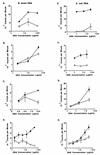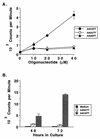DNA and a CpG oligonucleotide derived from Babesia bovis are mitogenic for bovine B cells
- PMID: 9784553
- PMCID: PMC108679
- DOI: 10.1128/IAI.66.11.5423-5432.1998
DNA and a CpG oligonucleotide derived from Babesia bovis are mitogenic for bovine B cells
Abstract
DNAs from bacteria and variety of nonvertebrate organisms, including nematodes, mollusks, yeasts, and insects, cause polyclonal activation of murine B lymphocytes. Similar studies have not been reported for bovine B cells, and to date no studies have reported mitogenic properties of protozoal DNA for any species. However, we and others have observed that protozoal parasite antigens can induce the proliferation of lymphocytes from nonexposed donors. Extending these studies, we now show that the mitogenic property of protozoal antigen preparations is in part attributable to parasite DNA and that Babesia bovis DNA is directly mitogenic for bovine B cells. DNase treatment of B. bovis extracts abrogated B. bovis-induced proliferation of peripheral blood mononuclear cells from nonexposed cattle. Like DNAs from other organisms that were mitogenic for murine B cells, B. bovis DNA is largely nonmethylated and induced a dose-dependent proliferation of bovine B cells, which was reduced upon methylation. Furthermore, B. bovis and E. coli DNAs enhanced immunoglobulin secretion by cultured B cells, inducing moderate increases in immunoglobulin G1 and stronger increases in immunoglobulin G2. Because certain nonmethylated CpG motifs present in bacterial DNA are known to stimulate proliferation of murine and human B cells, an 11-kb fragment of B. bovis DNA was analyzed for CG dinucleotide content and for the presence of known immunostimulatory sequences (ISS) centered on a CG motif. The frequency of CG dinucleotides was approximately one-half of the expected frequency, and several CpG hexameric sequences with known activity for murine B cells were identified. An oligodeoxynucleotide containing one of these ISS (AACGTT), which is present within the rhoptry-associated protein-1 (rap-1) open reading frame, was shown to stimulate B-cell proliferation. These ISS may be involved in host immune modulation during protozoal infection and may be useful as vaccine adjuvants.
Figures






Similar articles
-
Modulation of host immune responses by protozoal DNA.Vet Immunol Immunopathol. 1999 Dec 15;72(1-2):87-94. doi: 10.1016/s0165-2427(99)00120-8. Vet Immunol Immunopathol. 1999. PMID: 10614497 Review.
-
DNA from protozoan parasites Babesia bovis, Trypanosoma cruzi, and T. brucei is mitogenic for B lymphocytes and stimulates macrophage expression of interleukin-12, tumor necrosis factor alpha, and nitric oxide.Infect Immun. 2001 Apr;69(4):2162-71. doi: 10.1128/IAI.69.4.2162-2171.2001. Infect Immun. 2001. PMID: 11254571 Free PMC article.
-
Stimulation of T-helper cell gamma interferon and immunoglobulin G responses specific for Babesia bovis rhoptry-associated protein 1 (RAP-1) or a RAP-1 protein lacking the carboxy-terminal repeat region is insufficient to provide protective immunity against virulent B. bovis challenge.Infect Immun. 2003 Sep;71(9):5021-32. doi: 10.1128/IAI.71.9.5021-5032.2003. Infect Immun. 2003. PMID: 12933845 Free PMC article.
-
A novel 20-kilodalton protein conserved in Babesia bovis and B. bigemina stimulates memory CD4(+) T lymphocyte responses in B. bovis-immune cattle.Mol Biochem Parasitol. 2001 Nov;118(1):97-109. doi: 10.1016/s0166-6851(01)00375-9. Mol Biochem Parasitol. 2001. PMID: 11704278
-
Identification of candidate vaccine antigens of bovine hemoparasites Theileria parva and Babesia bovis by use of helper T cell clones.Vet Parasitol. 1995 Mar;57(1-3):189-203. doi: 10.1016/0304-4017(94)03120-l. Vet Parasitol. 1995. PMID: 7597783 Review.
Cited by
-
Signal transduction, gene transcription, and cytokine production triggered in macrophages by exposure to trypanosome DNA.Infect Immun. 2006 Aug;74(8):4530-7. doi: 10.1128/IAI.01938-05. Infect Immun. 2006. PMID: 16861639 Free PMC article.
-
Biased immunoglobulin G1 isotype responses induced in cattle with DNA expressing msp1a of Anaplasma marginale.Infect Immun. 1999 Jul;67(7):3481-7. doi: 10.1128/IAI.67.7.3481-3487.1999. Infect Immun. 1999. PMID: 10377129 Free PMC article.
-
Interplay between Attenuation- and Virulence-Factors of Babesia bovis and Their Contribution to the Establishment of Persistent Infections in Cattle.Pathogens. 2019 Jul 4;8(3):97. doi: 10.3390/pathogens8030097. Pathogens. 2019. PMID: 31277392 Free PMC article. Review.
-
Expression analysis and biological characterization of Babesia sp. BQ1 (Lintan) (Babesia motasi-like) rhoptry-associated protein 1 and its potential use in serodiagnosis via ELISA.Parasit Vectors. 2016 May 31;9(1):313. doi: 10.1186/s13071-016-1573-7. Parasit Vectors. 2016. PMID: 27245213 Free PMC article.
-
Babesia bovis-stimulated macrophages express interleukin-1beta, interleukin-12, tumor necrosis factor alpha, and nitric oxide and inhibit parasite replication in vitro.Infect Immun. 2000 Sep;68(9):5139-45. doi: 10.1128/IAI.68.9.5139-5145.2000. Infect Immun. 2000. PMID: 10948137 Free PMC article.
References
-
- Ballas Z K, Rasmussen W L, Krieg A M. Induction of NK activity in murine and human cells by CpG motifs in oligodeoxynucleotides and bacterial DNA. J Immunol. 1996;157:1840–1845. - PubMed
-
- Bird A P. CpG islands as gene markers in the vertebrate nucleus. Trends Genet. 1987;3:342–347.
-
- Branda R F, Moore A L, Mathews L, McCormack J J, Zon G. Immune stimulation by an antisense oligomer complementary to the rev gene of HIV-1. Biochem Pharmacol. 1993;45:2037–2043. - PubMed
Publication types
MeSH terms
Substances
Grants and funding
LinkOut - more resources
Full Text Sources
Research Materials

